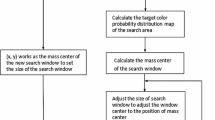Abstract
Traditional motion amplitude normalization technology cannot get the whole process of motion amplitude in the time and space domain, and there is a big error in motion image contour extraction, which leads to low accuracy and long time. Therefore, a motion amplitude normalized feature localization technique based on intelligent vision is proposed. The contour of the moving image is extracted by the method of color information segmentation. The motion process in time and space is simulated by intelligent vision, and the feature data are captured by the parameters of the human motion sensor. According to the horizontal rotation record and geomagnetic flux of the sensor, the feature data is processed by normalization, and the moving image features are selected by normalization. The amplitude function is established to optimize the foreground region feature marker of the motion image, and the motion amplitude standard feature location is realized. Experimental results show that the proposed method is more accurate and less time-consuming than the traditional method.







Similar content being viewed by others
References
Anzai Y, Yairi T, Takeishi N et al (2020) Visual localization for asteroid touchdown operation based on local image features. Astrodynamics 4(15):589–599
Yun Lin, Ya Tu, Zheng Dou, et al. Contour stella image and deep learning for signal recognition in the physical layer. IEEE Transactions on Cognitive Communications and Networking, https://doi.org/10.1109/TCCN.2020.3024610.
Mozaffari MH, Lee WS (2019) Domain adaptation for ultrasound tongue contour extraction using transfer earning: A deep learning approach, The Journal of the Acoustical Society of America 146(5):EL431
Ahmed M, Laskar RH (2019) Eye detection and localization in a facial image based on partial geometric shape of iris and eyelid under practical scenarios. J Electron Imaging 28(3):1
Kang L, Wei Y, Jiang J et al (2019) Robust cylindrical panorama stitching for low-texture scenes based on image alignment using deep learning and iterative optimization. Sensors 19(23):5310
Mopuri KR, Garg U, Babu RV (2019) CNN fixations: an unraveling approach to visualize the discriminative image regions. IEEE Trans Image Process 28(5):2116–2125
Hosseini MDM, Kirchner M (2019) Unsupervised image manipulation localization with non-binary label attribution, IEEE Signal Processing Letters, 2019:976–980
Redzic M, Laoudias C, Kyriakides I (2019) Image and WLAN bimodal integration for indoor user localization. IEEE Trans Mob Comput 19(99):1109–1122
Li W, Huang Q, Srivastava G (2020) Contour feature extraction of medical image based on multi-threshold optimization. Mobile Networks and Applications 2:1–9
Tu Y, Lin Y, Wang J et al (2018) Semi-Supervised Learning with Generative Adversarial Networks on Digital Signal Modulation Classification. CMC-Computers Materials & Continua 55(2):243–254
Erguvan Z, Louveaux M, Hamant O et al (2019) ImageJ SurfCut: A user-friendly pipeline for high-throughput extraction of cell contours from 3D image stacks. BMC Biol 17(1):1289–1299
Liu Y, Yang C, Sun Q (2020) Thresholds based image extraction schemes in big data environment in intelligent traffic management, IEEE Transactions on Intelligent Transportation Systems PP(99):1–9
Zarghampour F, Yamini Y, Baharfar M et al (2020) On-chip electromembrane extraction followed by sensitive digital image-based colorimetry for determination of trace amounts of Cr(VI). Anal Methods 12(3):569–579
Nafah F, Sophian A, Khan MR et al (2019) Abidin, Image-based feature extraction technique for inclined crack quanti cation using pulsed eddy current, Chinese Journal of. Mech Eng 32(02):113–121
Goyal A (2019) Image-based clustering and connected component labeling for rapid automated left and right ventricular endocardial volume extraction and segmentation in full cardiac cycle multi-frame MRI images of cardiac patients. Med Biol Eng Compu 57(6):1213–1228
Liu S, Wang S, Liu X, et al. (2021) Fuzzy detection aided real-time and robust visual tracking under complex environments. IEEE Transactions on Fuzzy Systems 29(1), 90–102
Hu S, Lee GH (2020) Image-based geo-localization using satellite imagery. Int J Comput Vision 128(5):1205–1219
Lin Y, Zhao H, Ma X, Tu Y, Wang M. Adversarial attacks in modulation recognition with convolutional neural networks, in IEEE Transactions on Reliability, dhttps://doi.org/10.1109/TR.2020.3032744.
Shuai L, Chunli G, Fadi A, et al. (2020) Reliability of response region: A novel mechanism in visual tracking by edge computing for IIoT environments, Mechanical Systems and Signal Processing, 138, 106537
Facs CSK (2019) Efficient and economical alternative to breast image-guided localization. J Am Coll Surg 229(4):526–538
Liu S, Wang S, Liu X, et al. (2021) Human memory update strategy: a multi-layer template update mechanism for remote visual monitoring, IEEE Transactions on Multimedia, 2021, 23, 2188–2198
Vallathan G et al (2020) Suspicious activity detection using deep learning in secure assisted living IoT environments. J Supercomput 30:1–9
Author information
Authors and Affiliations
Corresponding author
Additional information
Publisher's Note
Springer Nature remains neutral with regard to jurisdictional claims in published maps and institutional affiliations.
Rights and permissions
About this article
Cite this article
Qiao, L., Lin, J.CW. Research on Standardized Feature Positioning Technology of Motion Amplitude Based on Intelligent Vision. Mobile Netw Appl 27, 2391–2399 (2022). https://doi.org/10.1007/s11036-021-01883-6
Accepted:
Published:
Issue Date:
DOI: https://doi.org/10.1007/s11036-021-01883-6




